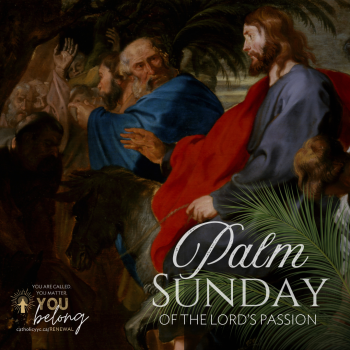There will be no Adoration on Thursday, May 1, 2025, as we will be preparing for the Confirmation Celebration that is at 6:00 pm. Regular Adoration will resume on Thursday, May 8, 2025 at 9:45 am to 9:00 pm.
_small.gif)
_small.gif)
Report for the months of January—April 2025 The St. Francis de Sales Ministry has helped a total number of 11 people for the months of January to April 2025. We paid out a total of $15,321.51 for bills, rent, or mortgages, as well, we gave a total of $1125.00 in fuel cards and $2200.00 in grocery cards. The total assistance we have given this period is $18,646.51 It is rewarding to be able to assist these people who are genuinely struggling. The help we give is so appreciated. We try to listen and give help as much as we can as quickly as possible.
A huge Thank You to all those who have made a donation to this rewarding ministry.

Palm Sunday marks the beginning of Holy Week in the Christian calendar, commemorating Jesus Christ's triumphal entry into Jerusalem, an event described in all four Gospels of the New Testament (Matthew 21:1-11, Mark 11:1-11, Luke 19:28-44, and John 12:12-19). It occurs the Sunday before Easter, and in 2025, it will fall on April 13, given that Easter Sunday is April 20.
The origins of Palm Sunday trace back to the life of Jesus, around 30-33 CE, when he entered Jerusalem riding a donkey, fulfilling the prophecy of Zechariah 9:9: "Rejoice greatly, Daughter Zion! See, your king comes to you, righteous and victorious, lowly and riding on a donkey." Crowds greeted him by waving palm branches and laying them on the ground, shouting "Hosanna," which means "save us" in Hebrew. This act symbolized victory, peace, and the recognition of Jesus as the Messiah. However, this triumphant moment was bittersweet, as it preceded his betrayal, arrest, and crucifixion later that week.
The celebration of Palm Sunday as a formal liturgical event developed in the early Christian Church. By the 4th century, pilgrims in Jerusalem reenacted Jesus’ entry during Holy Week, a practice documented by the Spanish nun Egeria in her travelogue around 381-384 CE. The tradition spread from Jerusalem to other Christian communities, becoming a widespread observance by the Middle Ages. In the Catholic Church, it evolved into a day of both joy and solemnity, reflecting the dual nature of Christ’s entry as a king destined for sacrifice.
For Catholics, Palm Sunday—officially called "Palm Sunday of the Passion of the Lord"—holds deep spiritual significance. The day begins with a blessing of palm branches (or other local greenery, like olive or willow branches, depending on the region). These blessed palms are distributed to the faithful, who often process into the church, recalling Jesus’ entry into Jerusalem. The Mass includes two Gospel readings: one recounting the triumphal entry and a longer "Passion Narrative" detailing Jesus’ suffering and death, emphasizing the shift from celebration to sacrifice.
The palms symbolize several things:
Catholics often keep blessed palms in their homes, sometimes braided into crosses, as a reminder of Christ’s sacrifice and a sacramental symbol of grace. The ashes used on Ash Wednesday the following year are often made by burning these palms, connecting the start of Lent to its culmination in Holy Week.
In essence, Palm Sunday invites Catholics to reflect on Jesus as a humble king who willingly embraced suffering for humanity’s salvation. It’s a day of paradox—celebration intertwined with sorrow—setting the stage for the mysteries of Good Friday and the joy of Easter.